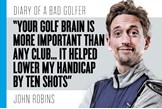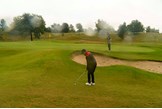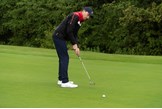Bad Golf’s John Robins: “How I halved my handicap in four months”
Published: Last updated:
After nearly halving his handicap in the space of four months, Bad Golf’s John Robins is officially a man worth listening to!
In his exclusive Today’s Golfer column, the comedian and BBC 5Live presenter details his spectacular journey to a handicap of 12.3 and doles out some shrewd advice on the everlasting importance of course management and mental mastery.
Well then, here we are, a year into my tenure as Today’s Golfer’s resident average golfer. I got my first official handicap just over a year ago and at the time of writing my first column I was off 20.5. Progress was slow and I hovered between 19 and 21 for about eight months. Then since this May things really hotted up. Last week I got down to 12.3, and as I prepare for the winter to give my scores a real hiding, I thought I might share some of the things I did to get to a handicap I never dreamed I’d play off.
RELATED: Lower scores in five easy steps

Firstly, and I hope this comes as a relief to some of you, my improvement hasn’t been down to a forensic analysis of my swing. In fact, the less I tried to visualise what I was doing, the lower my scores got and the clearer my head became on the course. That’s not to say I didn’t have advice, or make a few small changes, but they were both few and small. Most of what has improved my swing have been tweaks to my stance, grip and alignment. And I firmly believe that most mid to high handicappers would see huge improvements if they forgot about their swing, and focused on everything that comes before it.
How often do we find we hit the right shot in the wrong direction?! Creating a reliable aiming routine and making sure your body is aligned to the target are both simple and entirely within your control.
RELATED: Best Mid-Handicap Irons
Also, actually finding out where you are losing shots makes a huge difference. Though your driver slice may look ugly, and may annoy the hell out of you, it might not actually be what’s causing the big scores. Loosing twenty yards and playing from the rough pales into comparison when you tot up the four putts and duffed chips.
Know what is holding you back. For me it was bunkers and short putts, so I had a lesson on each and moved on with my game. It was a bit embarrassing to ask my local pro for a lesson on two foot putts, but it’s worked wonders.
Those big scores do have to go, not the bogeys and the doubles, but the sevens, eights and nines that keep you from your potential. There’s an incredible statistic someone told me – the difference between a score of 79, and a score of 95, is, on average, one birdie. That means a ten handicapper is making, on average, one more birdie per round than a twenty handicapper. Improving your handicap isn’t so much about becoming a better golfer, it’s about becoming a less worse golfer. So, how do we do that?

Well, I think it’s much more to do with your decision making and shot selection than the quality of your strike. When the Spanish goalkeeper Unai Simon failed to control a backpass and let the ball slip into the net against Croatia in the recent World Cup, he approached manager Luis Enrique to say that his mistake was haunting him. Enrique replied “If it had been a failure of concept I would be worried, but it was a failure of execution, so I am not”. In many ways this is the wisest thing anyone ever said about golf. Every golfer makes mistakes of execution, because golf is hard. From Rory McIlroy to a fifty-four handicap, we all hit shots that do not come out as intended, and we have to accept that. The difference between Rory McIlroy and a fifty-four handicapper, is that Rory is almost never playing the wrong shot.
RELATED: John Robins: “How I shot my lowest ever score”
Picture the scene, your drive curves right and bounces off the fairway into rough on a downslope, leaving you 190 yards from the green. When I was playing off 20 I would have picked a hybrid, or a three wood and gone for it, desperate to save my par. It would have gone wrong, perhaps hooking into trees or duffing forward into heavier rough at a cost of maybe two or three additional shots. Becoming a better golfer isn’t about suddenly being able to execute that shot, it’s about having the discipline not to attempt it.
One good way to school yourself into this way of thinking, is to play each hole as if it were one more than par, aiming for bogey golf. A mistake I see so often, is people grasping for par at all costs and ending up with four over, whereas a bogey would have been perfectly manageable. I was guilty of this mistake countless times, and it leads to so much frustration, because you are constantly comparing seeking perfection, and not reacting to the situation in front of you. It’s a cruel trick of golf, that the worse we are, the harder the shots we have to hit, from trees, awkward lies, bunkers and brambles while the single figure handicapper plays their shots from fairways and fringes, the better you get, the easier the shots you have to hit.

Ray Floyd listed the ten most common mistakes he saw average golfers make. What do you notice about his list?
“Underclubbing. Swinging too hard. Automatically shooting at the flag. Not playing away from trouble. Missing the green on the wrong side of the flag. Trying for too much out of trouble. Trying shots you’ve never practised. Panicking in the sand. Misreading turf and lie conditions. Underreading break on the green.”
Firstly, you may, like me, recognise many of the common mistakes you make. But more importantly, do you see how few of these mistakes are anything to do with swinging a golf club? Apart from ‘swinging too hard’ every single one of these mistakes is about the decisions we make before we even take our stance. Make it your mission to focus on course management and the mental aspect of the game. If you were to organise a playing lesson with your pro and put yourself in situations where you struggle, I bet you’d be surprised to find how rarely they even consider some of the shots you try to execute.
RELATED: John Robins: “My foolproof plan to break 90”
Your brain is the most important club in your bag, and learning how to use it could improve your handicap by ten shots.
The remaining things I’ve done are all pretty much mental. Learning how to keep concentration after a bad hole. Finding a B game and C game for when conditions or your swing are against you. I’ve focussed on remaining calm, and only having positive or neutral reactions to shots.
I also got a putting mat, and regularly hit 2-6ft putts in my living room. Not so much to hone my stroke, but just to have a relaxed memory of short putts for when I feel the nerves come as I stand over a tiddler. Often on course I will say in my head “You’re just in your living room John, just wait for the rattle!”
So really, the reason I don’t feel like I’m playing off 12.3, is because I’m not playing much better golf, I’m just playing much less bad golf! Which is very bad news for my brand!

WITB: Bad Golf’s John Robins
Click the club names to read reviews and tests of John’s clubs
Driver: Cobra King RadSpeed Loft: 10.5º set to 11.5º. Shaft: Tensei blue 65 reg
Hybrid: Cobra King Speedzone Loft: 2H. Shaft: Recoil reg
Irons: Cobra King Speedzone Lofts: 5-GW. Shafts: Recoil reg
Wedges: Cobra King MIM Lofts: 52º, 58º. Shafts: STD wedge shaft
Putter: Odyssey O-Works 2.0 R-Line
Golf ball: Bridgestone E6
Apparel: Puma




